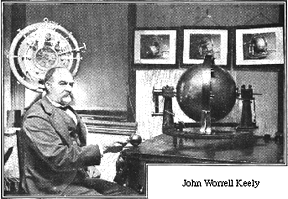
















I remember sitting as a young boy over a copy of Caesar's 'De bello gallico' and with the aid of a dictionary trying to extract some meaning from the jumble of alien words that confronted me.
It was not until years later, when I was considerably better at it, that I sat down and read the book in the original Latin just for fun. Suddenly something magical happened. I had studied Ceasar's exploits in Galle and all his other deeds at length, as was required in those days, but it was not until I read his words in his own language without having to translate that the man became real to me as a person, not as some historical figure I had to study to obtain my grades.
I had to do much the same with Keely.
Keely spoke in the language of an 18th century organ builder. If you don't believe me, find a book on organ building of that period and you'll be in for a treat. 400 pages of pure unadulterated Keelyspeak.
He must have been a dreadful bore to those around him, for much of his bombastic language was totally unnecessary. True he had to invent a technical language to explain his findings, but much of it was simply the character of the man. He was not a good communicator. Often he was his own worst enemy by the way he spoke. He would try to explain something and people did not understand. Keely then would lose patience and could be quite rude to honest people that were genuinely trying to comprehend what he was saying.
This made him many enemies. And it made him enemies where it counted, for often the recipients of his rudeness were the scientists and reporters of his day, people he should have been on amicable terms with.
Many of Keely's difficulties in life were simply a result of how he spoke to those around him.
Much of what Keely said dealt with harmonic relationships and the difficulties he had graduating his machines in order to establish the wavepatterns he needed.
Since we are first trying to establish the underlying principle we ignore all that for the moment as it is not helpful here.
What is left falls into two categories.
2) How he tried to EXPLAIN what he observed.
His theories are something else.
Keely had massive problems with his contemporaries. He had made certain discoveries in relation to resonance that enabled him to create phenomena that could not be explained with orthodox scientific concepts of the day.
People wanted an explanation. The pressures to present a coherent theory that covered all aspects of his findings were enormous.
In the end, to satisfy these demands, he tried to squeeze his observations into some metaphysical model that simply is inadequate. His 'triune stream' for instance, that he sees as "the cerebral emanations of the Creator" (his words, not mine) is not a helpful analogy.
Keely tells us everything. There is nothing estoric in what he did.
The reason no-one to date has been able to duplicate Keely's machines is the almost unbelievable precision with which he built his devices!
No-one today can raise the funds required to duplicate what he achieved by mechanical means. In today's money Keely spent many millions of dollars building and perfecting his machines. The cost of duplicating his devices with the precision Keey did is nowadays prohibitive.
But there is hope. By using electronics for much that Keely had to do with mechanics we can and will duplicate his motor!
Next Chapter:
UNLIMITED ENERGY
Contact:
Hans von Lieven, copyright 1999